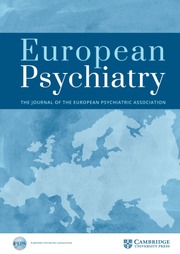No CrossRef data available.
Article contents
An attempt of factorial analysis of the typological formation of non-psychotic disturbances after brain damage
Published online by Cambridge University Press: 16 April 2020
Abstract
To find out the dynamic peculiarities of the formation of non-psychotic (neurotic) disturbances after brain damage, and how non-organic factors conduce to their development.
124 patients with non-psychotic disturbances after brain damage were examined (mean age-35.7±1.11, mean duration-6.23±0.57) by dynamic clinical-psychopathological method. Using specially designed questionnaires the social-psychological states of the patients were assessed. They also completed SCL-90.
The patients distributed into 3 groups according to psychopathological analysis of the neurotic syndromes. 31 of them developed asthenic-depressive disturbances (G1), 57–personality changes (G2), 36-hypochondriacal disturbances(G3). The number of patients after brain trauma in G3 was lower than in G1 (p<0.01) and G2 (p<0.001). After intoxications the number of patients in G3 was higher, than in G1 (p<0.05) and G2 (p<0.001). Significant differences were found by the burdened familial history of mental disorders and premorbid constitutional accentuations of personality between G1 and G3 (p<0.05). 51 patients of the G2 (89.5%) were affected by severe psychogenic factors, but only 10 patients in G1 (32.2%) and 8 patients in G3 (22.2%) had the same influences. So the number of distressed patients in the G2 was higher than in G1 (p<0.001) and G3 (p<0.001). The Hostility by SCL-90 is higher in G2, than in G1 (p<0.05) and G3 (p<0.001).
There is certainly interplay of organic and non-organic factors in the genesis of non-psychotic disturbances after brain damage. The hereditary, constitutional and psychogenic factors are of great importance in the typological formation of the neurotic syndromes after brain damage.
- Type
- Poster Session 2: Organic Mental Disorders and Memory and Cognitive Dysfunctions
- Information
- European Psychiatry , Volume 22 , Issue S1: 15th AEP Congress - Abstract book - 15th AEP Congress , March 2007 , pp. S302 - S303
- Copyright
- Copyright © European Psychiatric Association 2007



Comments
No Comments have been published for this article.